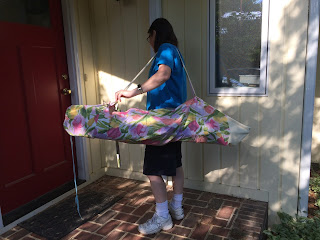Long ago—maybe it was ten
years ago, actually—my husband and I went to some event in our daughter’s
elementary school classroom. Her teacher talked about things they’d been doing,
and remarked that recently she had tried setting out a large selection of pens
for the kids to choose from for a writing assignment. She was surprised that getting
to choose a pen had made them more enthusiastic about actually writing. I, in
turn, was surprised that she was surprised.
Of course choosing a new pen would make them want to write with it!
Or does it not work that way with other grown-ups, the way it worked with those
kids?
Didn’t that teacher, when
she bought a new pen, find herself writing nonsense notes on a nearby scrap of
paper to try it out, followed perhaps by some more extended and coherent
remarks that happened to pop into her head as she watched the words appear in
clear black or bright blue or even a vivid red?
Well, maybe not. Maybe it’s
just me (and some other pen enthusiasts.)
I love pens. I like
pencils, too, but pens come in such a variety of colors and feels.
By “feels”, I mean the
difference between a gel pen oozing out a generous stream of viscous ink, and a
ballpoint, pressed firmly to paper and smoothly putting down a thin line. Or a
felt-tip, rubbed lightly along the page and leaving a vivid line of dye that
sinks into and sometimes through the paper, versus a fountain pen, whose metal
nib is run over the paper with hardly any pressure, leaving an equally inky,
though hopefully not quite as
penetrating, mark.
The above description
only applies to pens that aren’t running out of ink, of course, and to
ballpoints that run smoothly. A pen that is drying up is a frustrating object
and makes writing unpleasant. I think I have avoided certain kinds of pens—rollerballs,
in particular—because I’ve had too many experiences with ones that were halfway
dry. It isn’t fair to the rollerballs. When they are fresh and full of ink,
they write very well.
So part of the pleasure
of writing is the feel of the pen on the paper. Another is watching the words
appear. It helps if you have an interest in handwriting or calligraphy, so that
you like to play with their appearance. Neat and upright, or elegantly slanted.
Round and curly, or sharply angled, or full of flourishes. CAPITALIZED FOR
EMPHASIS, or underlined, or even in italics.
But even simple printing has something appealing about it when it fills a
notebook page.
There’s more to writing
than physically putting words on paper, of course. For me, writing is a way to
organize my thoughts. Writing them down allows me to see them all together and
keep track of them, in a way that I can’t easily do in my head. It’s so
important that during a time when wrist problems made it difficult for me to
write, I found it difficult to think as well.
I read a very interesting
book about writing a while ago, about the two very different problems of writer’s
block and hypergraphia-- The Midnight Disease: The Drive to Write, Writer’s Block, and the Creative Brain by Alice W. Flaherty. I’d like to quote two short segments from it on
hypergraphia.
“…Scientists are never
happy until they can assign a number to the phenomenon they are studying, and
researchers soon invented a simple way to do that with hypergraphia. They
mailed a short letter to their patients with epilepsy, asking them to describe
the state of their health. The average answer of patients without hypergraphia
was seventy-eight words. The patients thought to have hypergraphia averaged
five thousand words.” (p. 19)
“Hypergraphic handwriting
tends to have distinctive physical characteristics. Hypergraphics often use
highly elaborate or stylized scripts, even mirror writing like that used by
Leonardo da Vinci. For emphasis, they frequently write in all capitals or in
colored inks. They may not confine themselves to the main text, but may add
exuberant annotations, drawings in the margins, and illuminated initials. Lewis
Carroll, who most likely had temporal lobe epilepsy, exhibited several of these
peculiarities—including what he called looking-glass writing and an exclusive
reliance on purple ink—in the 98,721 letters he wrote from his late twenties
until his death at age sixty-five.” (p.26)
That’s a lot of letters.
While I don’t find myself
compelled to write, and don’t write to anything like the extent she describes
in her book, there is something about this description that strikes a chord.
Colored inks, elaborate scripts—of course. Annotations and marginal drawings?
How wonderful! In moderation, anyway.
But I was talking about
pens earlier and now I’m talking about writing, which leads me to wonder—how do
people with hypergraphia feel about pens? Do they love trying out new pens and
rediscovering old ones, or does the implement they use not matter? The author’s
comment about colored inks suggests that it isn’t entirely irrelevant, so now I’m
curious.
I’m also wondering why
Lewis Carroll relied exclusively on purple ink. His signature color, maybe? I
think I’d get tired of writing in the same color all the time.












